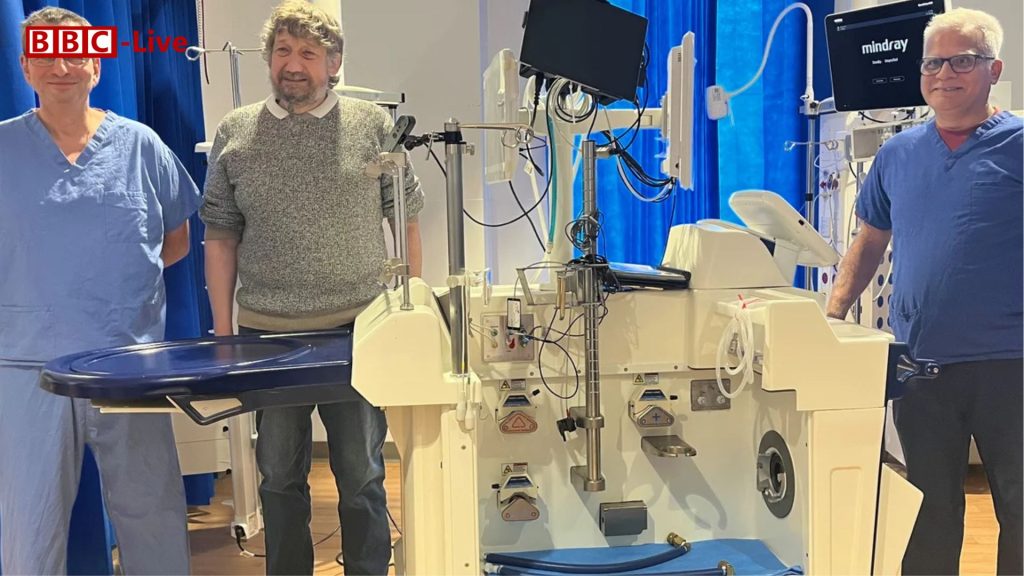
Double-Lung Transplant Performed Using Innovative Machine in the UK
A Milestone in Organ Transplantation
Surgeons in the UK have recently achieved a remarkable feat. They successfully performed a double-lung transplant using a new machine designed to revive donor lungs. This procedure is the first of its kind in the country. It represents a significant breakthrough in the field of organ transplantation.
Introducing the XPS System
The machine used in this groundbreaking transplant is called the XPS system. This revolutionary device can breathe new life into donor lungs. It uses a special chamber that contains pumps and filters. These components work together to repair and revitalize the lungs before they are transplanted into patients. The process is known as ex-vivo lung perfusion (EVLP). This method mimics natural body conditions by allowing the lungs to inflate and deflate as they would inside a human body.
Challenges with Traditional Methods
Traditionally, donated lungs have been preserved by cooling them to just above freezing. This method slows down the organs’ metabolic processes. However, there are significant challenges with this approach. Once the lungs are cooled, it becomes nearly impossible to properly assess their quality. Without a thorough evaluation, many viable organs are discarded. This results in wasted opportunities for life-saving transplants.
Evaluating and Revitalizing Organs
The XPS system changes this process. It gives surgeons a way to assess and rehabilitate the lungs in a controlled environment. This innovation significantly extends the time for evaluation. It increases the chances of using more viable organs for transplants. Experts believe this could greatly reduce the number of wasted donor organs. Ultimately, this could save hundreds of lives every year.
A Success Story: Daniel Evans-Smith
One of the first patients to benefit from this new technology is Daniel Evans-Smith. He is a 49-year-old events manager who had been living with chronic obstructive pulmonary disease (COPD). This debilitating condition had caused severe breathing restrictions. After receiving new lungs treated with the XPS system, Evans-Smith woke up from surgery to a remarkable change. His COPD had completely disappeared. “It’s amazing. The difference is phenomenal,” he said. His story reflects the life-changing impact that this technology can have on patients’ health.
Improving Donor Lung Utilization
Before the XPS system, only one in five donated lungs was used for transplants. This was due to the uncertainty surrounding the condition of the lungs. The previous cooling method left doctors with limited options to evaluate lung quality. As a result, many potentially viable organs were wasted. Patients frequently faced long wait times for suitable donors.
The transplant was performed at Royal Papworth Hospital in Cambridge. This hospital is a leading center for lung transplants in the UK. The surgical team, led by Marius Berman, Giuseppe Aresu, and Pradeep Kaul, successfully executed the procedure using the EVLP technique. Since Evans-Smith’s transplant, three more patients have received similar transplants.
Real-Time Lung Assessment
The XPS system offers a real-time assessment of the lungs. Doctors can now inflate and deflate the lungs while monitoring their performance. This innovative process allows for better evaluation compared to the old cooling method. The system’s fluid helps maintain lung function, enabling preservation for up to six hours. If the lungs perform well during this period, they can be prepared for transplantation.
Life-Saving Potential for Patients
For patients on the waiting list for lung transplants, this technology could be life-saving. Currently, over 200 people are on the UK waiting list for lung transplants. The introduction of the XPS system could help increase the number of suitable donor organs. This means reduced waiting times and potentially better outcomes for patients.
Professor Derek Manas, the national medical director for organ and tissue donation at NHS Blood and Transplant, shares optimism for the new technology. He believes it could help decrease the number of patients on the waiting list. More lives could be saved if more viable organs become available.
Commentary from Experts
Jasvir Parmar, chair of the NHS Lungs Advisory Group, highlights the significance of the XPS system. He notes that it not only provides a better tool for assessing organ quality but also improves lung function before transplantation. “Once you have the lungs out of the body, you are then able to improve their performance,” he explains, pointing out the dual benefits of this system.
Evans-Smith’s Journey to Recovery
Evans-Smith continues his recovery journey and is now experiencing dramatic improvements in his daily life. No longer burdened by COPD, he can walk long distances without struggle. “I used to struggle just walking up a hill. Now, I can do 7,000 steps a day,” he shared with gratitude. His story is an inspiring example of the potential benefits this technology can bring to lung transplant recipients.




